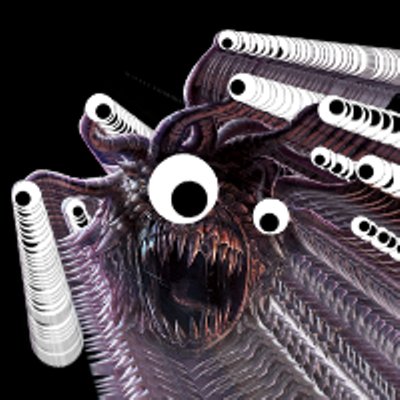Name a new video! Win a Prize*!
- BasharOfTheAges
- Just zis guy, you know?
- Joined: Tue Sep 14, 2004 11:32 pm
- Status: Breathing
- Location: Merrimack, NH
- Malificus
- Dr. Malpractice
- Joined: Sat Aug 03, 2002 2:55 pm
- Location: St. Paul, Minnesota
- Contact:
Events in the series refer to Judeo-Christian symbols from the book of Genesis and Biblical apocrypha among others. Later episodes shift focus to psychoanalysis of the main characters, who display various emotional problems and mental illnesses; the nature of existence and reality are questioned in a way that lets Evangelion be characterized as "postmodern fantasy". Hideaki Anno, the director of the anime series, had suffered from clinical depression prior to creating the series, and the psychological aspects of the show are based on the director's own experiences with overcoming this illness
 *
*
- Ileia
- WHAT IS PINK MAY NEVER DIE!
- Joined: Mon Aug 09, 2004 12:29 am
- Status: ....to completion
- Location: On teh Z-drive, CornDog
- Contact:
- CrackTheSky
- has trust issues
- Joined: Sun Aug 27, 2006 11:01 pm
- Status: Maybe editing?
- Location: Chicago
"Experimental evidence has shown that the speed of light is independent of the motion of the source. It has also been confirmed experimentally that the two-way speed of light (for example from a source, to a mirror, and back again) is constant. It is not, however, possible to measure the one-way speed of light (for example from a source to a distant detector) without some convention as to how clocks at the source and receiver should be synchronized[3]. Einstein (who was aware of this fact) postulated that the speed of light should be taken as constant in all cases, one-way and two-way.
The speed of light (c) is now viewed as a fundamental physical constant. This postulate, together with the principle of relativity that all inertial frames are equivalent, forms the basis of Einstein's theory of special relativity.
It is worth noting that it is the constant speed c, rather than light itself, that is fundamental to special relativity; thus if light is somehow manipulated to travel at less than c, this manipulation will not directly affect the theory of special relativity.
Observers traveling at large velocities will find that distances and times are distorted in accordance with the Lorentz transforms; however, the transformations distort times and distances in such a way that the speed of light remains constant. A observer moving with respect to a collection of light sources would find that light from the sources ahead was shifted toward the violet end of the spectrum that from those behind was redshifted.
If information could travel faster than c in one reference frame, causality would be violated: in some other reference frames, the information would be received before it had been sent, so the "effect" could be observed before the "cause". Such a violation of causality has never been recorded.
A light cone defines locations that are in causal contact and those that are not.
A light cone defines locations that are in causal contact and those that are not.
To put it another way, information propagates to and from a point from regions defined by a light cone. The interval AB in the diagram to the right is "time-like" (that is, there is a frame of reference in which event A and event B occur at the same location in space, separated only by their occurring at different times, and if A precedes B in that frame then A precedes B in all frames: there is no frame of reference in which event A and event B occur simultaneously). Thus, it is hypothetically possible for matter (or information) to travel from A to B, so there can be a causal relationship (with A the "cause" and B the "effect").
On the other hand, the interval AC in the diagram to the right is "space-like" (that is, there is a frame of reference in which event A and event C occur simultaneously, separated only in space; see simultaneity). However, there are also frames in which A precedes C (as shown) or in which C precedes A. Barring some way of traveling faster than light, it is not possible for any matter (or information) to travel from A to C or from C to A. Thus there is no causal connection between A and C.
According to the currently prevailing definition, adopted in 1983, the speed of light is exactly 299,792,458 metres per second (approximately 3×108 metres per second, or about 30 centimetres (1 foot) per nanosecond).
Astronomical distances are sometimes measured in light years (the distance that light would travel in one year, roughly 9.46×1012 kilometres or about 5.88×1012 miles). Because light travels at a large but finite speed, it takes time for light to cover large distances. Thus, the light we observe from distant objects in the universe was emitted from them long ago: in effect, we see their distant past."
The speed of light (c) is now viewed as a fundamental physical constant. This postulate, together with the principle of relativity that all inertial frames are equivalent, forms the basis of Einstein's theory of special relativity.
It is worth noting that it is the constant speed c, rather than light itself, that is fundamental to special relativity; thus if light is somehow manipulated to travel at less than c, this manipulation will not directly affect the theory of special relativity.
Observers traveling at large velocities will find that distances and times are distorted in accordance with the Lorentz transforms; however, the transformations distort times and distances in such a way that the speed of light remains constant. A observer moving with respect to a collection of light sources would find that light from the sources ahead was shifted toward the violet end of the spectrum that from those behind was redshifted.
If information could travel faster than c in one reference frame, causality would be violated: in some other reference frames, the information would be received before it had been sent, so the "effect" could be observed before the "cause". Such a violation of causality has never been recorded.
A light cone defines locations that are in causal contact and those that are not.
A light cone defines locations that are in causal contact and those that are not.
To put it another way, information propagates to and from a point from regions defined by a light cone. The interval AB in the diagram to the right is "time-like" (that is, there is a frame of reference in which event A and event B occur at the same location in space, separated only by their occurring at different times, and if A precedes B in that frame then A precedes B in all frames: there is no frame of reference in which event A and event B occur simultaneously). Thus, it is hypothetically possible for matter (or information) to travel from A to B, so there can be a causal relationship (with A the "cause" and B the "effect").
On the other hand, the interval AC in the diagram to the right is "space-like" (that is, there is a frame of reference in which event A and event C occur simultaneously, separated only in space; see simultaneity). However, there are also frames in which A precedes C (as shown) or in which C precedes A. Barring some way of traveling faster than light, it is not possible for any matter (or information) to travel from A to C or from C to A. Thus there is no causal connection between A and C.
According to the currently prevailing definition, adopted in 1983, the speed of light is exactly 299,792,458 metres per second (approximately 3×108 metres per second, or about 30 centimetres (1 foot) per nanosecond).
Astronomical distances are sometimes measured in light years (the distance that light would travel in one year, roughly 9.46×1012 kilometres or about 5.88×1012 miles). Because light travels at a large but finite speed, it takes time for light to cover large distances. Thus, the light we observe from distant objects in the universe was emitted from them long ago: in effect, we see their distant past."
- Kitsuner
- Maximum Hotness
- Joined: Sun Feb 16, 2003 8:38 pm
- Status: Top Breeder
- Location: Chicago, IL
- Kristyrat
- Time-traveling penguin
- Joined: Sun Sep 26, 2004 7:31 pm
- Status: Lies and fish
- Location: Igloo
- Contact:





